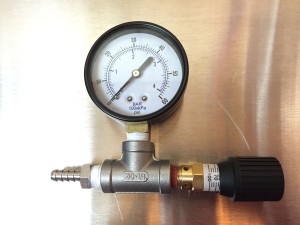
Building A Spunding Valve – Option 3

A Spunding Valve allows you to maintain a set pressure. If pressure in the pressure vessel exceeds the set point, it is expelled.
Some homebrewing applications…
- Pressurized fermentation. Ferment in a 5 or 10 gallon corny keg and use your Spunding Valve instead of an airlock. This allows you to ferment at your desired pressure.
- Dry hop under pressure. This allows you to dry hop earlier while reducing oxygenation. Active yeast are more likely to metabolize oxygen that’s introduced during dry hopping during active fermentation. Since CO2 is not exiting beer as vigorously under pressure, wanted compounds, flavors and aromas are more likely to stay in your beer under pressure.
- Naturally and accurately carbonate beer right in the keg.
- An airlock replacement. Keep the valve wide open for non-pressurized fermentations. Only do this if you have plenty of head space. This wouldn’t make a great blow off tube.
- Keg to keg transfers. Use the Spunding Valve to allow excess gas to exit the receiving keg as you transfer under pressure. Helps you achieve a slow, controlled and pressurized transfer.
- Fix over-carbonated beers. Use the same general process as for carbonation (skipping the addition of fermentable sugar). Use a carbonation chart to determine proper pressure for the temperature the keg is at. The Spunding Valve allows excess pressure to vent until the new carbonation level is achieved. You can agitate the keg to fix carbonation more quickly.
- Test for keg leaks. Pressurize your keg to serving pressure. Put the Spunding Valve on (with the pressure set well above your serving PSI) and note the reading. The gauge should remain steady. If pressure drops, you know you have a keg leak. It’s worth noting that this checks the entire keg including gas body o-ring. That spot is hard to check and other way as it’s only in function when the gas QD is on. When the gas QD is on… it’s difficult to spray and check for bubbles underneath the gas QD. Thanks to Scott Janish for this tip!
- As an airlock for long term aging of beers. Airlocks can run dry over time. A Spunding Valve will not. Thanks to Twitter Follower [Connect with HBF on Twitter] @BionicBrewing for this tip!
Option #3 – Build a Spunding Valve for more information and additional configuration options
- Control Devices CR Series Brass Pressure Relief Valve, 0-100 psi Adjustable Pressure Range, 1/4″ Male NPT
- Zenport DPG60 Zen-Tek Dry Air Pressure Gauge, 60 PSI
- Stainless Steel 304 Cast Pipe Fitting, Tee, Class 150, 1/4″ NPT Female
- Dixon Valve TTB75 PTFE Industrial Sealant Tape, -212 to 500 Degree F Temperature Range, 3.5mil Thick, 520″ Length, 3/4″ Width, White
- Parker 316 Stainless Steel Barb Connector To Male Pipe 1/4″ Hose Barb 1/4″ Male NPT
See: Build a Spunding Valve for more information and additional configuration options
This post contains affiliate links. We may make a commission when you use our Amazon links. This will never cost you extra. Thank you for supporting Homebrew Finds!
pinned amazonpst:spundingbuild3
$42 for the Cast Pipe Fitting? Does that sound right? That piece alone is a reason to just buy the one from Williams. I’m hoping that a mistake on the seller’s part.
Umm… no. That switched over to a pack of 25 because the single count went out of stock. Any 1/4″ x 1/4″ x 1/4″ stainless t with npt threads should work fine.
That makes it all better!